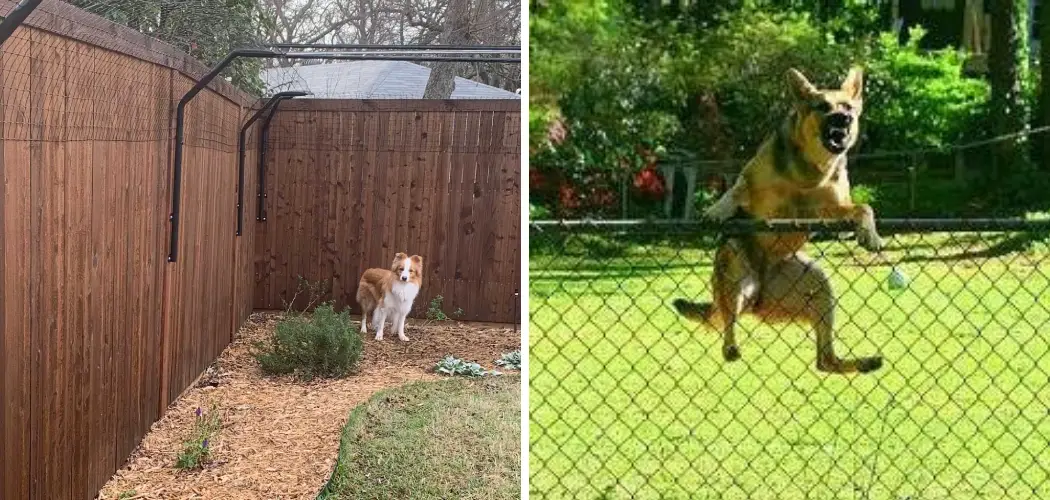Many dog owners are confronted with the challenge of how to keep dogs from climbing fences, a behavior that can lead to potential hazards such as getting lost, injuring themselves, or even causing harm to others.
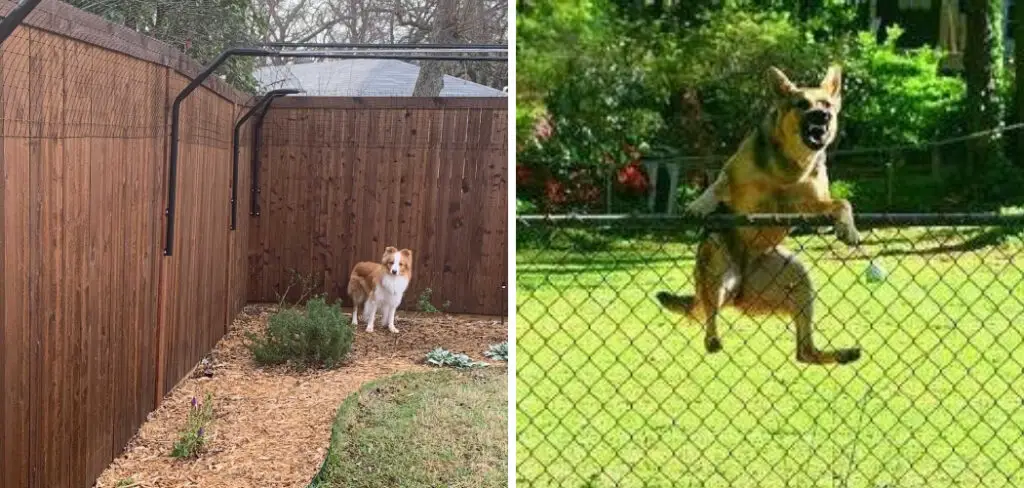
Climbing fences might seem like a minor issue, but it can stem from a myriad of underlying causes, such as separation anxiety, hunting instincts, or sheer boredom. Understanding the root cause of why a dog is attempting to scale a barrier is crucial for implementing the most effective preventative measures.
Without this insight, any solution applied might be futile, temporary, or could inadvertently exacerbate the problem. Hence, before delving into the array of available strategies ranging from training techniques to physical fence modifications, it is essential to address the ‘why’ behind a dog’s escape attempts to ensure a safe and happy environment for our canine companions.
Reasons Why Dogs Climb Fences
Boredom and Lack of Stimulation:
Dogs require regular physical exercise and mental enrichment to stay happy and healthy. A lack of these can lead to various behavioral problems, including the inclination to climb fences in pursuit of adventure or stimulation.
Dogs suffering from boredom might attempt to scale the fence to escape a monotonous environment, which can pose dangers such as traffic accidents or hostile encounters with other animals.
Actionable solutions include increasing daily exercise, such as longer walks or jogs that cater to your dog’s energy levels. Enriching their environment with interactive toys, puzzle feeders, and regular playtime can also mitigate boredom-induced climbing.
Additionally, incorporating training sessions throughout the day provides mental stimulation while strengthening your bond with your dog.
Anxiety and Fear:
Separation anxiety, fear of loud noises, or unsettling sights can incite a dog’s instinct to escape by climbing over the fence. This climb can endanger the dog and indicate underlying emotional distress.

To alleviate anxiety-driven climbing, desensitization techniques can be implemented, gradually exposing the dog to the source of fear in a controlled manner. Providing safe, comforting spaces within the confines of the fence offers a secure retreat. Consulting with a professional trainer or behaviorist can be essential for addressing deep-rooted fears and anxieties.
Chasing Animals or Objects:
The sight of a squirrel or a blowing leaf can trigger a dog’s innate predilection to chase. Such external stimuli can be irresistible, leading a dog to attempt an escape by climbing the fence, thus increasing the risk of becoming lost or injured.
To deter this type of behavior, blocking the dog’s view of these distractions with visual barriers can be effective. In addition, establishing a buffer zone or running track away from the fence can help manage their chasing urges. Addressing the attraction’s source may reduce the risk of climbing when feasible.
Predatory Instincts and Curiosity:
Certain breeds may be more inclined to climb fences due to their inherent predatory instincts or natural curiosity. Understanding your dog’s breed-specific traits can provide insight into their motivations, allowing for more targeted interventions.
It’s crucial to tailor preventive measures to align with these breed traits. Constructing a securely enclosed environment that caters to your dog’s instinctual needs without limiting their natural behaviors can help satisfy their curiosity within boundaries.
Assessing Your Fence and Environment
When seeking how to keep dogs from climbing fences, it’s essential to begin by scrutinizing the barriers currently in place around your property. Different types of fences have varying levels of effectiveness against a dog’s climbing abilities.
For instance, with their solid panels and lack of footholds, wooden fences generally discourage climbing attempts better than chain-link fences, which can act almost like ladders for determined dogs. However, a wooden fence with horizontal rails also presents climbing opportunities, so ensure the design is smooth and difficult to scale. Chain-link fences may need covers or rollers at the top to deter climbers.
Metal and vinyl fences are often sleek and offer fewer grip points, making them harder to climb, though they should also be tall enough to provide a physical barrier. To reinforce any type of weak fence, consider adding coyote rollers, lean-ins, or higher sections to discourage your pet from jumping or scaling the fence.
Next, inspect the surrounding area for potential climbing aids. Dogs can use anything from outdoor furniture to garbage cans and even nearby trees as makeshift ladders. Removing or relocating these items can remove the ‘tools’ your dog might use to facilitate their escape.

Finally, examine the entirety of your fence for any gaps, loose panels, or signs of damage. Dogs can often squeeze through surprisingly small openings or take advantage of weakened areas to chew or push their way through.
Regular maintenance to repair such vulnerabilities is imperative.
If there are areas that cannot be fixed immediately, temporary barriers or deterrents should be put in place to secure those weaknesses.
Overall, perimeter assessment and improvement are fundamental steps in creating a secure environment. It’s crucial to do frequent inspections and promptly address any potential escape routes your dog may discover.
Initial Safety Measures and Preventative Training
Active supervision during outdoor playtime is one of the most critical steps in preventing dogs from climbing fences. Constant monitoring allows you to intervene before an escape attempt occurs and allows you to engage directly with your dog.
Make playtime within the confines of the fence fun and rewarding by introducing fetch games, agility courses, or hide-and-seek activities to keep them stimulated and content within boundaries.
Basic obedience training is another cornerstone of prevention. Commands such as “leave it” and “come” are invaluable when your dog’s attention shifts towards potential climbing triggers. You can find resources like local obedience classes, online dog training courses, or instructional books to build up these commands. Daily practice in various scenarios reinforces these commands, creating a reliable way to manage and redirect your dog’s behavior.
Positive reinforcement solidifies the desirability of staying within the fence. Rewarding your dog with treats, praise, or a favorite toy for following commands and staying away from the fence inculcates compliance that is motivated by the immediate satisfaction of positive outcomes rather than fear of negative consequences.
This method encourages good behavior and strengthens the bond between you and your dog, making it an increasingly mutually enjoyable environment.
How to Keep Dogs from Climbing Fence: Physical Fence Modifications
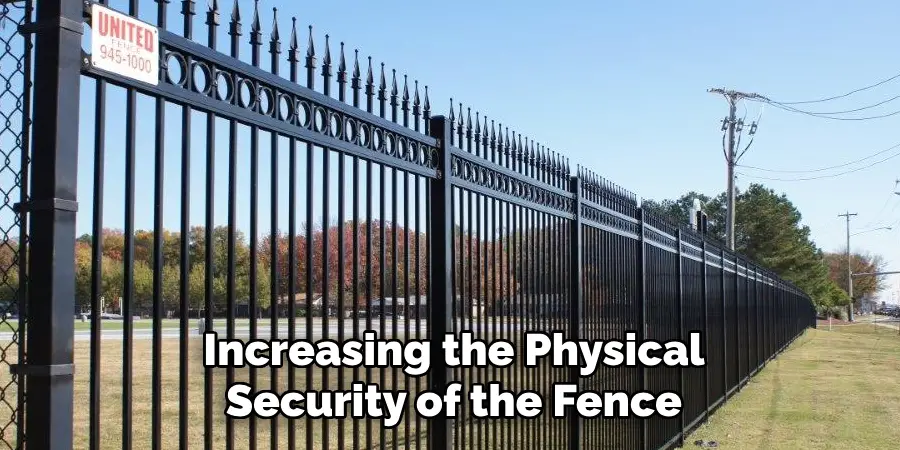
Increasing the physical security of the fence is the next logical step in deterring dogs from climbing. These modifications can range from simple DIY fixes to more advanced solutions. Still, all serve the same purpose: to create a more formidable barrier that dissuades any attempt to scale or escape.
1. Height Extensions
Fence extensions are particularly useful for taller breeds or persistent climbers dogs. Extending the height of your current fence can be done using a variety of materials. L-footers, which are angled steel barriers, can be attached along the top of the fence to create an overhang that is challenging to climb. Mesh panels can also be added to increase height and serve as a visual block, particularly effective when combined with climbing deterrents like spiky strips. Furthermore, specialized fence toppers made of a wide variety of materials, including decorative options, can add height and style simultaneously.
The cost for these extensions can vary significantly based on the material quality, aesthetic design, and length of coverage needed. For instance, mesh panels might cost between $50-$200, while aesthetically pleasing fence toppers can range from a few hundred to over a thousand dollars. Installation considerations include ensuring structural stability, adherence to local building codes, and possibly professional assistance for integrating extensions seamlessly with existing structures.
2. Fence Rollers
Consider installing coyote rollers or similar spinning bars to prevent your dog from gaining a foothold on top of the fence. These rollers, which sit atop the fence and spin when touched, make it difficult for animals to get the grip they need to pull themselves over. Not only are these rollers highly effective, but they also have minimal visual impact on the property’s appearance.
They can, however, be on the pricier side, potentially running into hundreds of dollars for a full fence line installation, and not all dogs may be deterred by rollers alone. Moreover, the moving parts require regular maintenance to ensure their effectiveness.
3. Fence Slants and Overhangs
Angled fence tops or overhangs create an additional obstacle for climbers by making the act of climbing counterintuitive and physically challenging. DIY options include attaching L-brackets to the top of the fence to create an angled extension. Pre-made angled fence panels are also available for a more finished look.
Professional installation may be advisable for more complex modifications, as it guarantees that the slant or overhang will be structurally sound and effective.
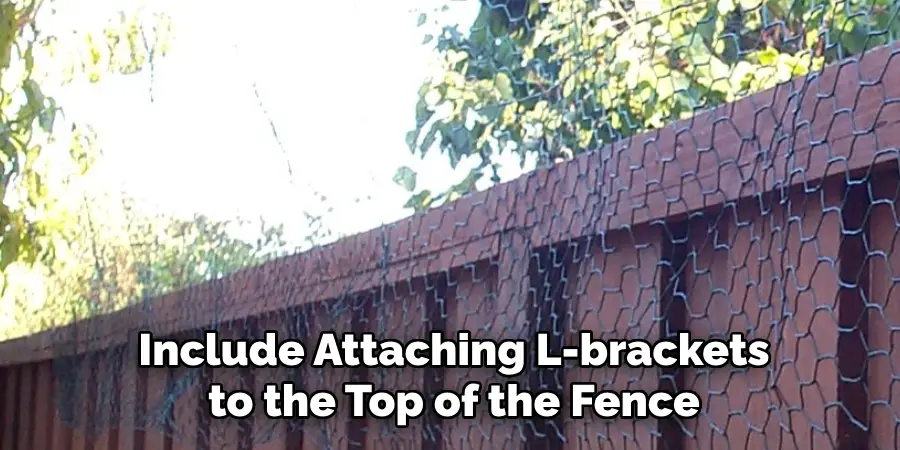
4. Reinforcing Weak Points
Regular inspections can help identify weak points in the fence foundation or structure. Methods to reinforce these weaknesses include pouring additional concrete around the fence posts for sturdiness, using metal braces to strengthen joints, or digging deeper fence posts to prevent undermining by dogs who dig. These durable and often permanent solutions solidify the fence’s foundation and overall resistance to climbing attempts.
5. Underground Fencing (Optional)
In addition to physical boundary modifications, invisible electric fence systems serve as a perimeter deterrent and can supplement existing physical barriers. These underground fences are less intrusive visually but require careful consideration and professional installation to guarantee safety and effectiveness.
Training your dog to understand the boundaries of an invisible fence is crucial to prevent stress or confusion. It’s important to note that such systems have limitations—some dogs may ignore the mild electric correction in pursuit of a strong enough stimulus, and these fences do nothing to prevent other animals from entering the yard.
Costs can vary widely, depending on the size of the property, and professional installation is strongly recommended to ensure the system functions correctly.
Each of these physical fence modifications can play a vital role in curbing the problematic behavior of fence-climbing dogs. The best approach often involves combining several tactics to reinforce the message that the boundary is insurmountable, ensuring the safety and security of your pet.

How to Keep Dogs from Climbing Fence: Deterrents and Training Techniques
Creating a multi-sensory barrier can further enhance your fence’s ability to deter your pet from unwanted climbing behavior. Let’s explore some strategies that can be employed.
Visual and Olfactory Deterrents
For visual deterrents, consider incorporating motion-activated sprinklers. These devices can startle your dog away from the fence line and are particularly useful for pets that are sensitive to unexpected movement or sounds. Similarly, fake security cameras can serve as a psychological barrier, leveraging a dog’s natural wariness of new objects in their sightline.
Olfactory deterrents are another effective measure. Dogs have a keen sense of smell, making things like citrus sprays or cayenne pepper (used judiciously and safely to avoid discomfort or harm) unappealing to be near. These can be applied around the fence perimeters to form an invisible line that your dog is reluctant to cross. It’s crucial, however, to rotate these sensory deterrents regularly to prevent the dog from becoming accustomed to them—which may reduce their effectiveness over time.
Redirection and Positive Reinforcement
Keeping your dog’s attention away from the fence is key inside the boundary. Providing engaging toys and activities can greatly reduce the temptation to scale the barriers. When your dog does show interest in the fence, redirection through commands followed by rewards can shift their focus and reinforce compliance.
For instance, calling your dog to you and rewarding them when they come can be much more effective than trying to stop them when they’re already at the fence. Consistent, positive reinforcement, over time, can significantly diminish fence-related behaviors.
Desensitization Techniques
In the case of specific anxieties, such as noise phobia or fear of unfamiliar stimuli outside the fence, desensitization techniques might be necessary. Desensitization involves gradual exposure to the source of fear in a controlled setting, thereby reducing the dog’s reaction over time.
Due to the meticulous nature of this process, the guidance of a professional dog trainer or behaviorist may be essential for addressing more complex issues.
Ensuring that your dog feels safe and engaged within their environment is an integral part of preventing fence climbing. When necessary, owners can establish a supportive and secure atmosphere that decreases the likelihood of escapism and reinforces positive behavior within the confines of their property by utilizing an array of visual and olfactory deterrents, redirection tactics, and desensitization techniques.
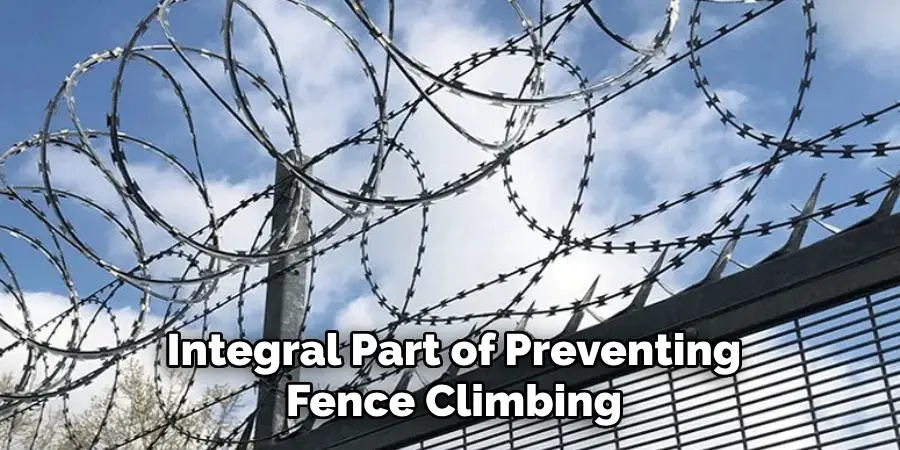
Breed-Specific Considerations
Certain dog breeds are inherently more prone to climbing due to their instincts or physical attributes. For example, terriers are known for their tenacity and high energy levels, often leading to inventive escape attempts. Breeds such as the Siberian Husky and Basenji are skilled jumpers and climbers, utilizing their agility and strength to overcome obstacles that would contain other breeds.
Understanding these breed-specific traits is crucial for implementing effective containment solutions. For terriers, enrichment activities that channel their digging and climbing urges into acceptable outlets are particularly beneficial. For agile breeds like the Husky, installing higher fences that account for their jumping ability and an inward-slanting top extension to prevent them from getting a grip can be a sound strategy.
Additionally, breeds known for their persistence, such as Beagles or Bloodhounds, may require more advanced deterrents and training methods to quell their exploratory nature. The use of olfactory deterrents can be especially effective, as these breeds rely heavily on their sense of smell.
It’s important to emphasize that while breed characteristics can provide valuable insights, individual personality traits are also pivotal considerations when choosing the right solutions.
A one-size-fits-all approach is less likely to be successful; instead, tailoring strategies to meet your dog’s specific needs will lead to better and more humane containment outcomes.
Importance of Professional Help and Ongoing Monitoring
When dealing with persistent climbers or complex canine anxieties, seeking professional help from trainers or behaviorists can be indispensable. These experts have the knowledge and skills to identify underlying issues and customize a training regimen suited to your dog’s specific needs. Their insight often proves critical in modifying challenging behaviors safely and effectively.
Moreover, ongoing monitoring of your dog’s interaction with their environment is crucial. Keeping a close eye on your pet’s fence-related behavior and making note of any attempted or successful escapes allows you to adjust your strategy accordingly. Just as crucial is recognizing when additional professional assistance may be warranted.
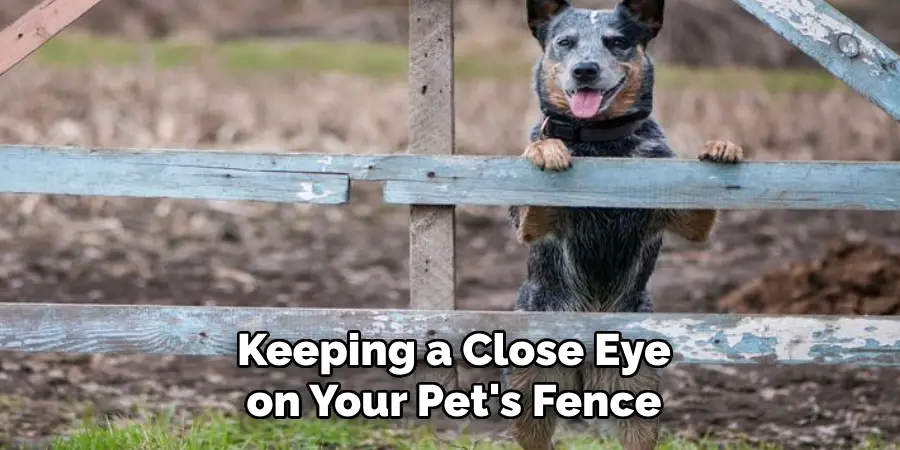
Documenting your dog’s behavior, the measures you’ve taken, and the outcomes of such interventions cannot be overstressed. By maintaining a log, you create a valuable reference that can help track the effectiveness of your methods. This informed approach enables a tailored response that evolves with your dog’s progress, ensuring your containment strategies remain humane, effective, and supportive of their well-being.
Incorporating professional advice with diligent monitoring and documentation sets a foundation for a dynamic and responsive plan aimed at preventing fence-climbing behavior. It underscores an investment in your dog’s safety and your peace of mind, custom-fit to unfold positively over time.
Conclusion
The journey of mastering how to keep dogs from climbing fences is multifaceted, calling for a blend of preventive strategies, behavior modification techniques, and a deep understanding of individual canine needs. The use of deterrence—whether visual or olfactory—alongside redirection and positive reinforcement proves effective in dissuading escape attempts.
For dogs with strong instincts, customized solutions tailored to breed-specific behaviors are essential. It is imperative to remember that persistent issues or complex anxieties might require the nuanced expertise of professionals who can offer tailored guidance and support.
In the end, safeguarding our beloved companions within the bounds of home necessitates patience, persistence, and ongoing vigilance. Owners are encouraged to actively observe and document their dog’s behavior, seeking out professional help when traditional methods fall short.
May this serve as a touchstone, providing both knowledge and confidence to ensure the safety and contentment of your dog and the serenity of knowing you have taken well-informed, compassionate steps toward a secure and happy home.

